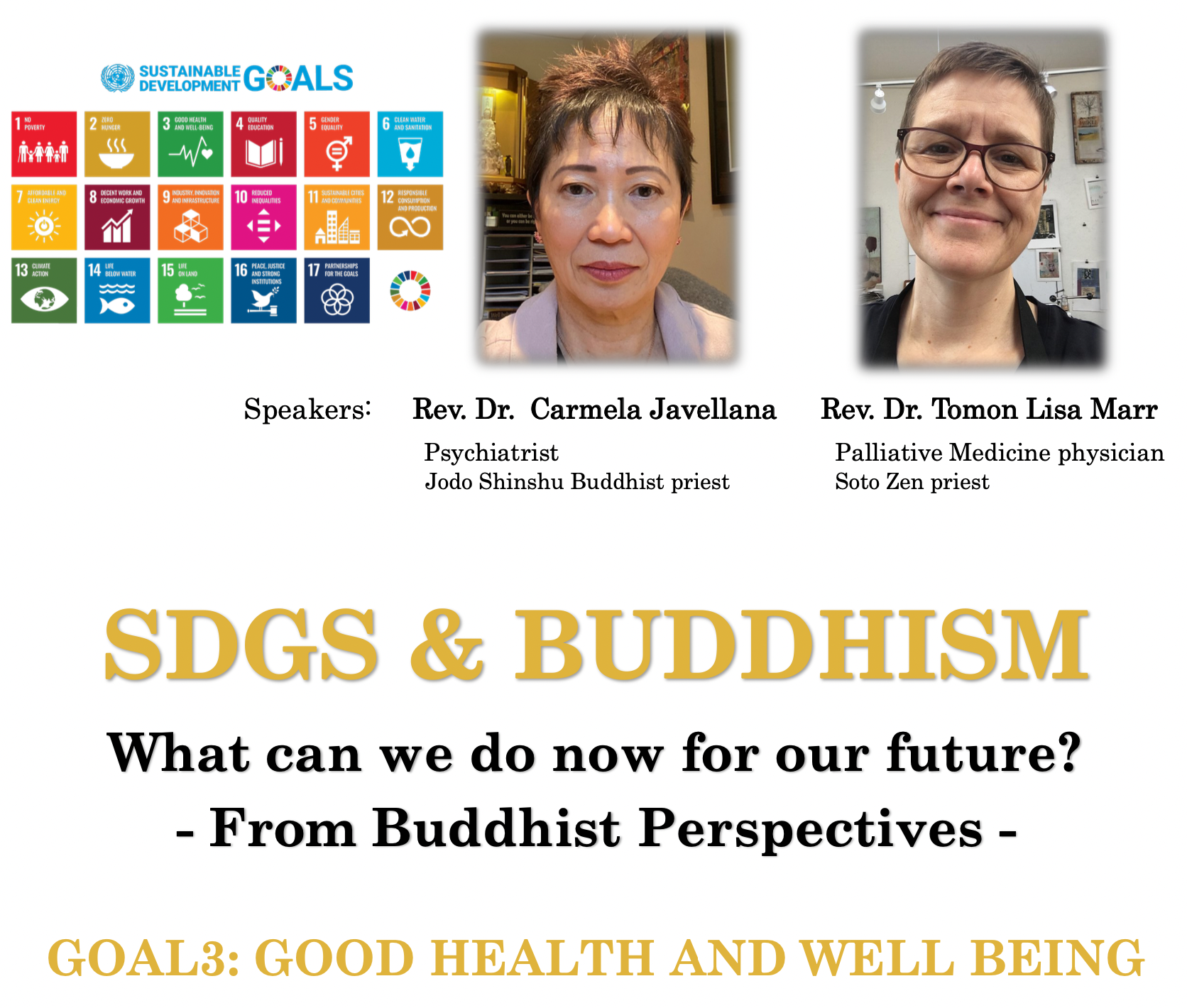
Buddhist leaders tackled “Good Health and Well Being” in an online forum last week, the third of the United Nations Sustainable Development Goals (SDGs), along with the theme, “What can we do now for our future? Buddhist Perspectives.”
The forum was hosted by the Bay Area Buddhist Association, an alliance of Buddhist organizations representing Soto Zen, Jodo Shinshu, and Nichiren Buddhism. The group hopes Buddhist leaders and laypeople of all stripes join them in addressing great challenges facing the world today, including education, hunger, climate change, clean water, affordable energy and other pressing problems. The association, which was founded two years ago, took the mantle declared at a 2018 world Buddhist conference in Japan supporting the UN’s goals. This forum was the fourth held since December 2020. A forum last December addressed the challenge of world hunger.
The forum, held online, featured keynote speakers Rev. Dr. Carmela Javellana, psychiatrist and Jodo Shinshu priest based in Salt Lake City, Utah, and Rev. Dr. Tomon Lisa Marr, palliative medicine physician and Soto Zen priest, based in Albuquerque, New Mexico. The forum’s moderator was Dr. Penny Murata, pediatrician and Jodo Shinshu Buddhist.
“Western medicine addresses illness, not wellness,” Dr. Javellana said. Our health care system only hears from people when they are sick. Homoeostasis means returning to balance in one’s life, both physically and mentally, which she sees as a form of Buddhist compassion.
Dr. Javellana is an unabashedly proclaimed Buddhist in private practice who feels the teachings help her provide care and understanding to patients, and help patients understand themselves. With a medical practice based in Salt Lake City, Utah, where Mormonism is the predominant religion, she said prospective patients are interested in alternative approaches.
Particularly important to her are the guiding words of Pure Land Buddhism, “Namu Amida Butsu,” which mean “I take refuge in the Buddha of Infinite Wisdom and Compassion.” She says that wisdom can help patients “take refuge from their illness.”
“I try to explain this to my non-Buddhist patients, especially in the context of healing,” she says. “They no longer need to bear the pain of their illness.”
Usually to understand where patients are mentally coming from and to hear their stories, several consultation sessions are needed, which she calls “marinating in the mud.” She often reassures them by explaining how Jodo Shinshu for example says all beings are filled with ignorance and blind passions.
In understanding their pain, wisdom is possible. She said, “The wound is where the light enters you.” She showed a picture of a broken bowl mended with liquid gold, creating a distinctly unique and beautiful work of art. “I tell people, ‘it’s okay that life sucks because you still benefit from the Buddha’s compassion.’”
It’s helpful to be mindful of what you consume mentally, Dr. Javellana said, similar to watching your diet and avoiding harmful foods. Watching the news or disturbing dramas affect us mentally and physically. “You become what you feed your mind,” she said. Instead, she suggests, “Feast on the dharma” (Buddhist teachings).
It may take some time, but greed and anger can transform into gratitude and appreciation, she said, even decades after deep-seated trauma. The Buddha’s compassion “helps glue us back together.”
For Dr. Tomon Lisa Marr, health care needs to be more like Avalokiteshvara, the multi-arm bodhisattva. Instead of focusing merely on the disease or illness, a multi-faceted approach is needed. That’s the approach taken by her palliative care team, which consists of doctors, nurses, nurse practitioners, social workers and chaplains. Suffering is not just physical, she said, but can be emotional, spiritual, social and existential for patients and families facing life-threatening illnesses.
“We’re not a death denying society,” Dr. Marr says, “we’re a suffering denying society.”
As a doctor at a large hospital, Dr. Marr doesn’t wear her Buddhist identity on her sleeve, but does find strength, support, and guidance in the teachings. Although facing burnout is a constant challenge, she never tires of listening to patients and their stories and figuring out how to help and treat people. She sees Dharma as a healing rain that can touch everyone.
Bay Area Buddhist Association may be contacted at sdgsbayarea@gmail.com
-Rev. Yamada is editor at Shinshu Center of America

